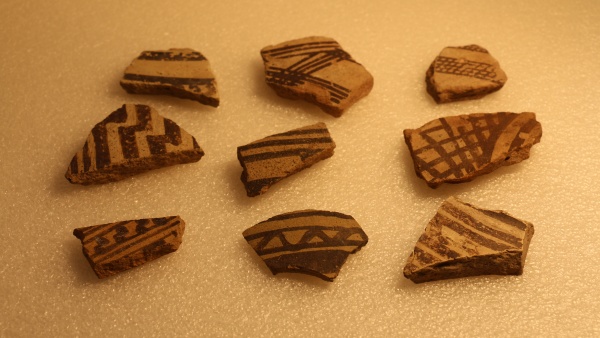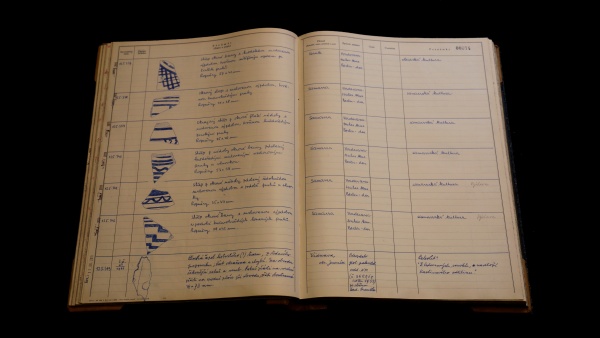28.03.2016 | In the archaeological collection of the National Museum, there are many artefacts that do not come from the territory of the Czech Republic, but from other countries. The finds coming from Lusatia, Austria, the Balkans, France, Scandinavia and the Middle East can serve as examples.

It is the artefacts from the Middle East that make the most numerous museum collections - the exotic collections of the department of Prehistory and Classical Antiquity of the National Museum. From the Middle East, the most comprehensive collection is from the chipped-stone industry of historical Palestine, which the National Museum acquired in the 1940s from Jaroslav Petrbok (1881-1960).
Nine shards from Iraq came to our collections as a gift from the Vorderasiatische Museum in Berlin. These are painted shards from the locations Samarra and Warka (which corresponds to ancient Uruk). The shards from both locations are dated to the Chalcolithic period (the Copper Age), or the Aeneolithic period, as it is often referred to in the Middle East. The fragments of pottery from Samarra originate in the oldest Mesopotamian Chalcolithic culture named after this site – the Samarra culture (approximately 5,500–4,800 BCE). The pottery from Warka belongs to the Ubaid culture (ca 4,500 – 3,500 BCE), which was a successor to the Samarra culture.

The Samarra pottery was made by hand. However, it is assumed that the vessels were finished on a tournette (slow wheel). The ochre-coloured vessels were decorated with brown or dull red paint. Geometrical decorations are predominant, but anthropomorphic and zoomorphic motifs also appear. For the very first time, the decorative swastika element is used on the pottery here. The influence of this culture spread along the Euphrates to other lands, for example the area of Elam in present-day Iraq and Cicilia in what is now Eastern Turkey. However, the influence of Samarra can also be observed; for example, in the Greek Neolithic Sesklo culture.
 The ʽUbaid culture named after the Tell al-ʽUbaid location near ancient Ur refers to a Chalcolithic culture of southern Mesopotamia. The term ʽUbaid culture refers to the Chalcolithic period in Mesopotamia in general (i.e. from 5,000 BCE), which also includes the Eridu and Haji Muhammad cultures; or it can mean the Ubaid culture of the Late Chalcolithic period The Ubaid culture named after the Tell al-ʽUbaid location near ancient Ur refers to a Chalcolithic culture of southern Mesopotamia. The term Ubaid culture refers to the Chalcolithic period in Mesopotamia in general (i.e. from 5,000 BCE), which also includes the Eridu and Haji Muhammad cultures; or it can mean the Ubaid culture of the Late Chalcolithic period. The ʽ Ubaid pottery is characterised by simple shapes. The ochre or greenish vessels were decorated with brown or black geometrical designs. In shape and decoration, the Ubaid pottery is much like the Samarra pottery, although it manifests influences from Iran.
The ʽUbaid culture named after the Tell al-ʽUbaid location near ancient Ur refers to a Chalcolithic culture of southern Mesopotamia. The term ʽUbaid culture refers to the Chalcolithic period in Mesopotamia in general (i.e. from 5,000 BCE), which also includes the Eridu and Haji Muhammad cultures; or it can mean the Ubaid culture of the Late Chalcolithic period The Ubaid culture named after the Tell al-ʽUbaid location near ancient Ur refers to a Chalcolithic culture of southern Mesopotamia. The term Ubaid culture refers to the Chalcolithic period in Mesopotamia in general (i.e. from 5,000 BCE), which also includes the Eridu and Haji Muhammad cultures; or it can mean the Ubaid culture of the Late Chalcolithic period. The ʽ Ubaid pottery is characterised by simple shapes. The ochre or greenish vessels were decorated with brown or black geometrical designs. In shape and decoration, the Ubaid pottery is much like the Samarra pottery, although it manifests influences from Iran.
Both the Samarra and the ʽUbaid were developed agricultural civilizations. Their people lived in houses made of unfired clay and lived by raising crops and livestock. The construction of irrigation channels was typical.
The fragments of Samarra and ʽUbaid pottery are not on show for the first time; some of them have appeared in the archaeological exhibition in the historical building of the National Museum. These shards were introduced here to juxtapose with contemporary pottery from the Czech environment.
Written by Ľubomír Novák, from the department of prehistory and classical Antiquity of the National Museum.
(EK)
Archeologie Historie Hudba Lidová kultura Mimoevropské kultury Osobnosti Přírodní vědy Rekonstrukce Restaurování Rukopisy a tisky Umění Vánoce Výstavy
Muzeum 3000, zpravodajský portál Národního muzea, odhaluje jedinečná tajemství. Více se dozvíte zde!